The Amount of Electric Vehicle Charging Points in Every Country
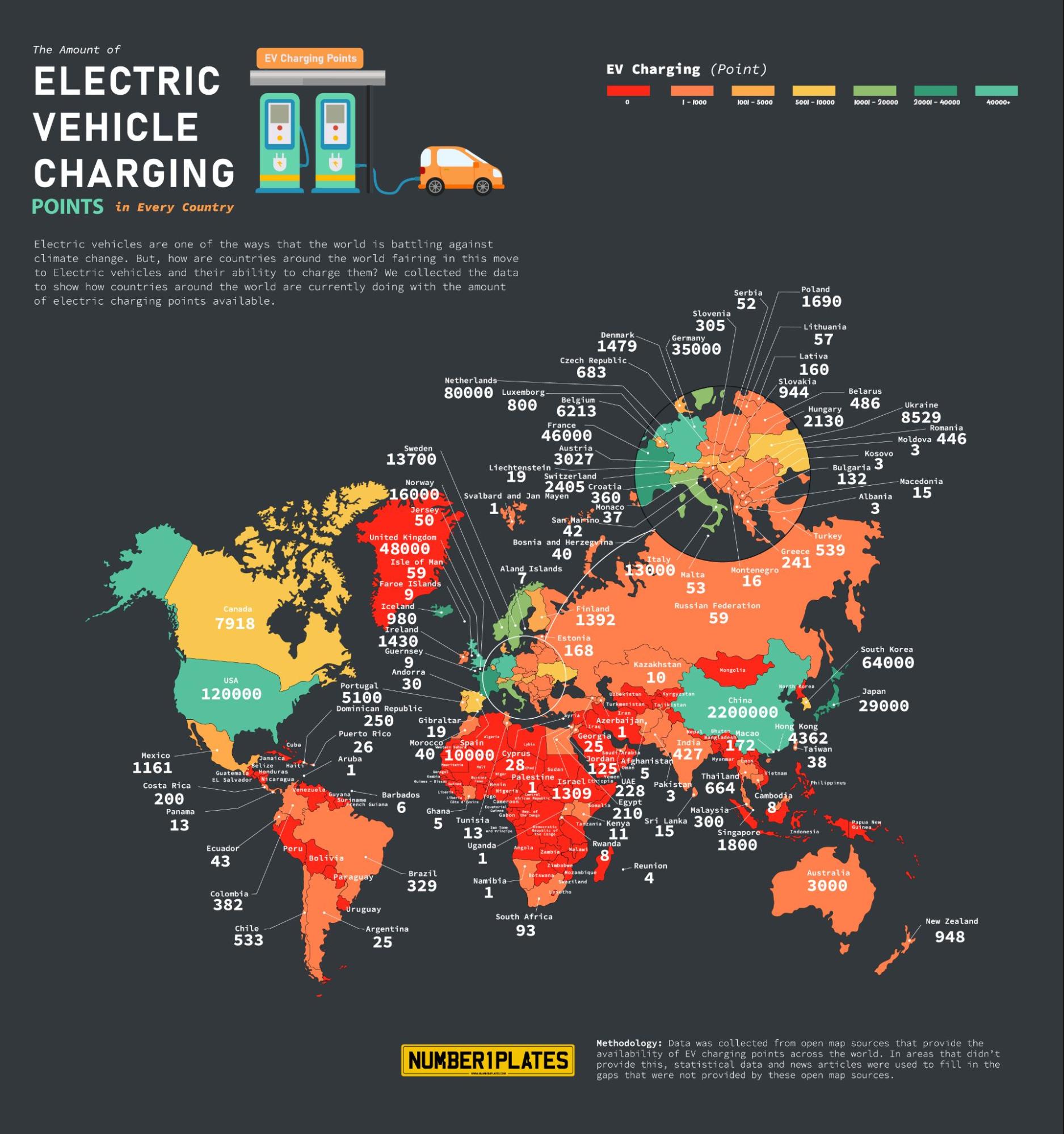
The need for adaptability in an ever changing climate is more apparent than ever. Electric vehicles are one of the ways forward. Several countries in the world such as the UK are planning to ban the sales of petrol and diesel vehicles from 2030 in order to tackle the climate crisis. Yet, how are countries around the world fairing in the adoption of EV’s?
To present this, we’re collecting data on the numbers of available EV charging points across the world. As of right now, China is leading the charge in providing electric vehicle charging points for EV drivers. The US comes in second, yet the availability per state isn’t as available compared to some. For example the state of California has 34,775 available charging ports yet some states are still below a thousand. Europe in general is leading in terms of adaptability. As most nations are gearing up for an eco-friendly solution in the coming years.
Ranking the top 10 countries for electric vehicle charging points
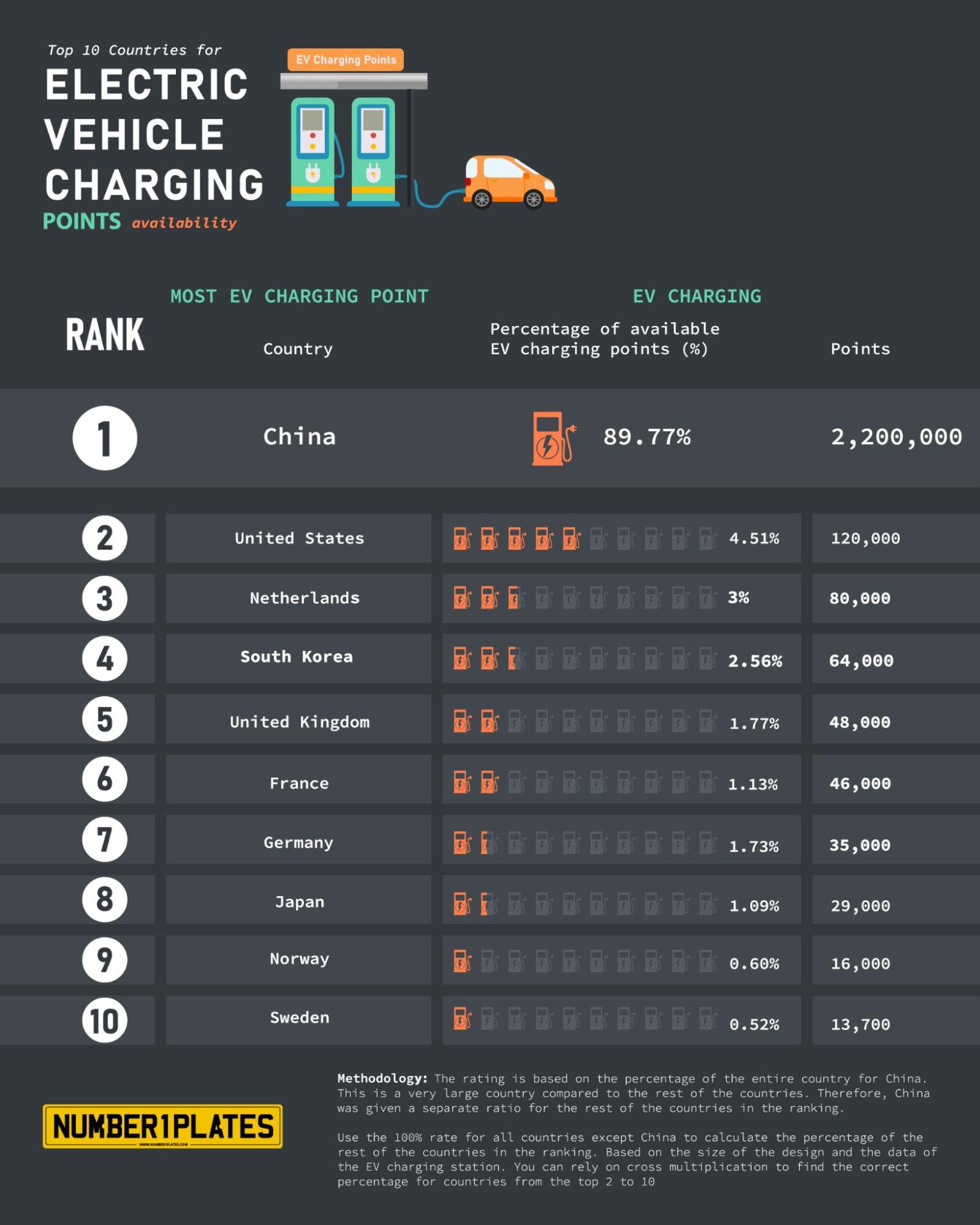
Europe
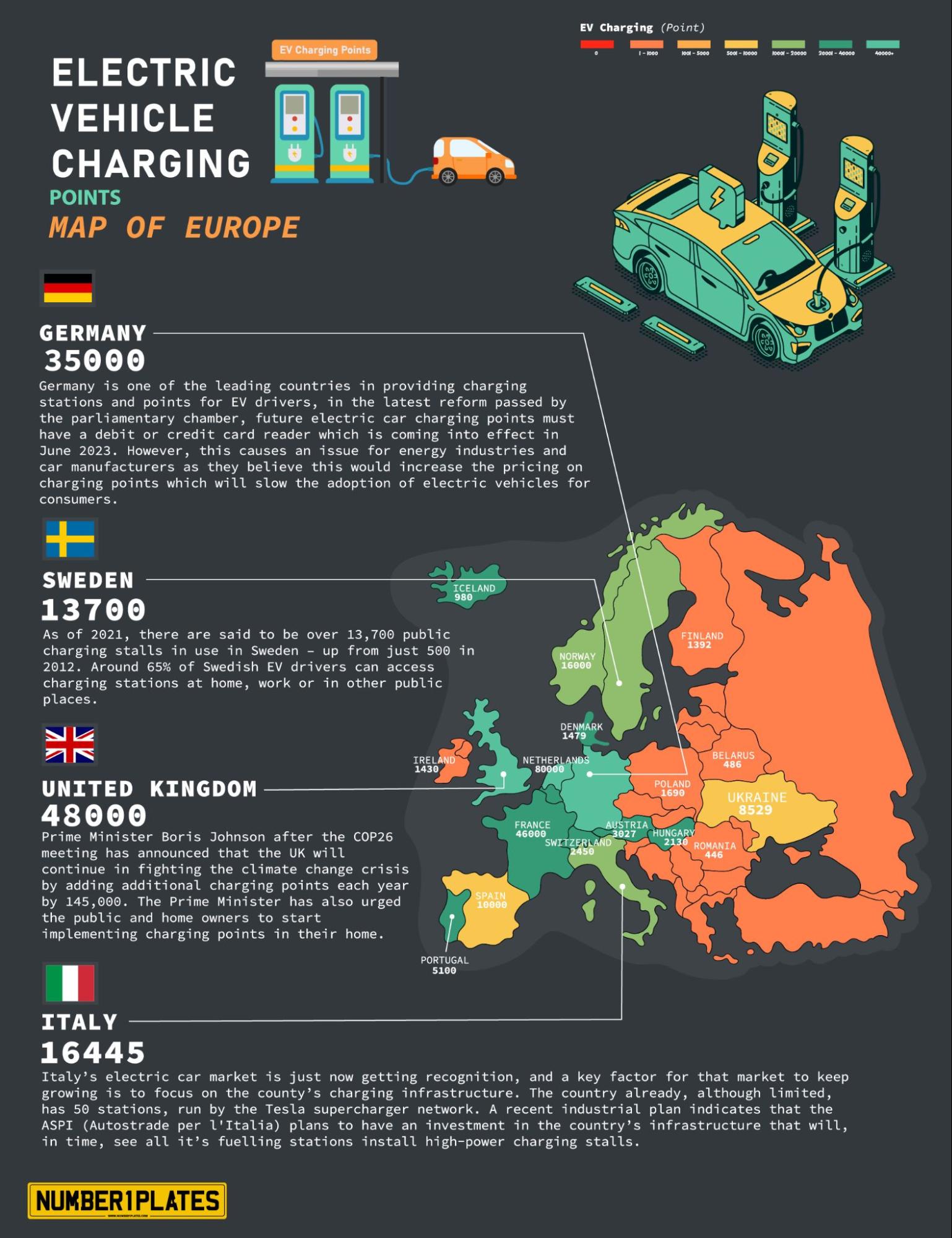
A common fear surrounding electric vehicles is the possibility of running out of energy when covering long distances. Fortunately, the existing network of fast public chargers across Europe makes it possible for EV drivers to travel far and fast. This year on average the EU offers five fast public chargers for every 100 km.
As the number of electric cars on our roads are constantly growing, you can see from our map that Europe, especially countries such as Germany and the United Kingdom
are continuously improving in regards to their EV charging infrastructure.
Key Findings
- UK – Prime Minister Boris Johnson after the COP26 meeting has announced that the UK will continue in fighting the climate change crisis. Mainly by adding additional charging points each year by 145,000. The Prime Minister has also urged the public and home owners to start implementing charging points in their home.
- Germany – Germany is one of the leading countries in providing charging stations and points for EV drivers. In the latest reform passed by the parliamentary chamber, future electric car charging points must have a debit or credit card reader. This is coming into effect in June 2023. However, this causes an issue for energy industries and car manufacturers. This is as they believe this would increase the pricing on charging points which will slow the adoption of electric vehicles for consumers.
- Italy – Italy’s electric car market is just now getting recognition, and a key factor for that market to keep growing is to focus on the county’s charging infrastructure. The country already, although limited, has 50 stations, run by the Tesla supercharger network. A recent industrial plan indicates that the ASPI (Autostrade per l’Italia) plans to have an investment in the country’s infrastructure that will, in time, see all it’s fuelling stations install high-power charging stalls.
- Sweden – As of 2021, there are said to be over 13,700 public charging stalls in use in Sweden – up from just 500 in 2012. Around 65% of Swedish EV drivers can access charging stations at home, work or in other public places.
North America
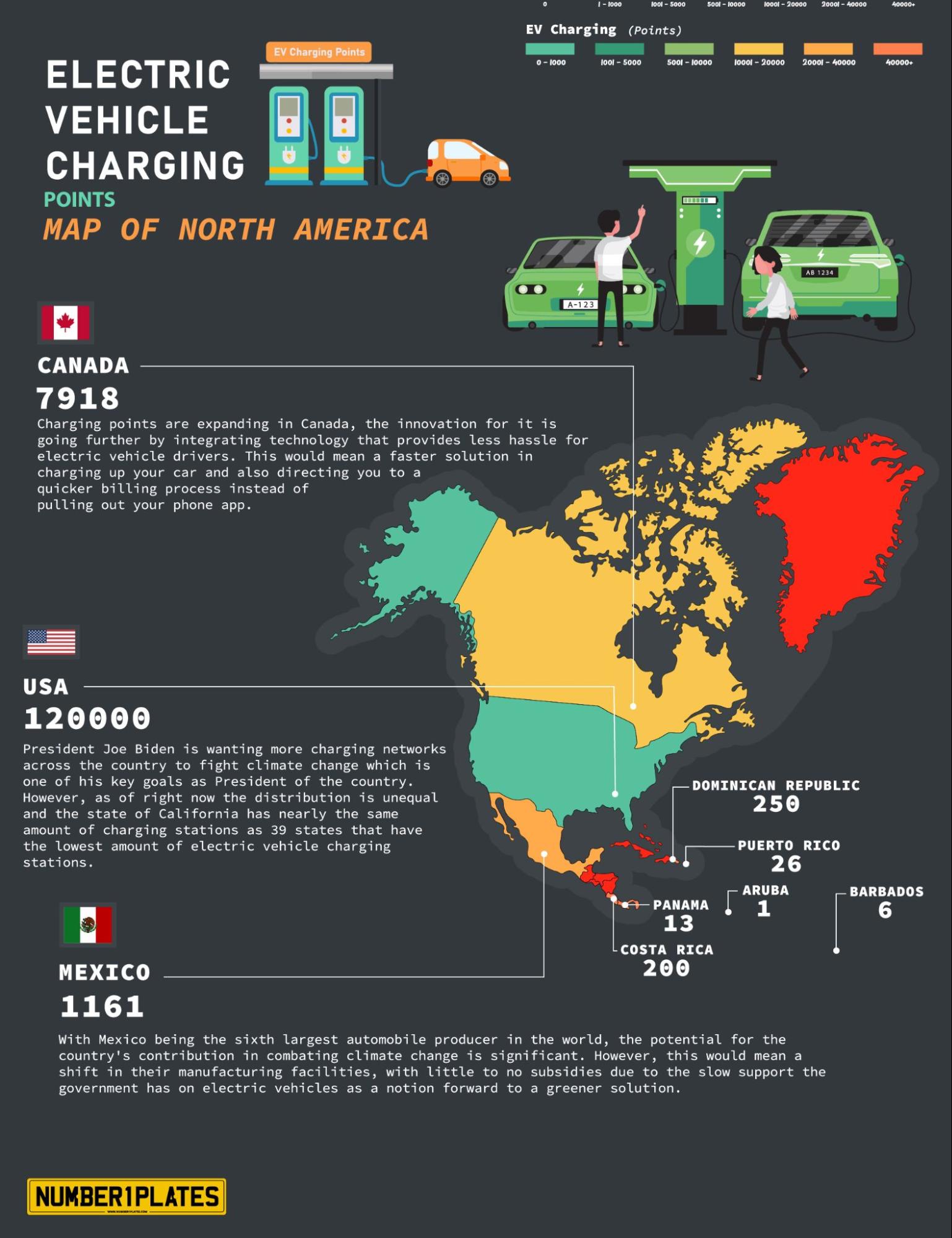
North America continues to set ambitious targets. In an aim to electrify their transport networks to reduce carbon emissions and mitigate climate change. Specifically, President Joe Biden is targeting a fund allocation of $5 billion for states to increase the availability of EV charging stations. This had led to a total of $1 trillion in investments.
Key Findings
- USA – President Joe Biden is wanting more charging networks across the country to fight climate change which is one of his key goals as President of the country. However, as of right now the distribution is unequal and the state of California has nearly the same amount of charging stations as 39 states that have the lowest amount of electric vehicle charging stations.
- Mexico – With Mexico being the sixth largest automobile producer in the world, the potential for the country’s contribution in combating climate change is significant. However, this would mean a shift in their manufacturing facilities, with little to no subsidies due to the slow support the government has on electric vehicles as a notion forward to a greener solution.
- Canada – Charging points are expanding in Canada, the innovation for it is going further by integrating technology that provides less hassle for electric vehicle drivers. This would mean a faster solution in charging up your car and also directing you to a quicker billing process instead of pulling out your phone app.
South America
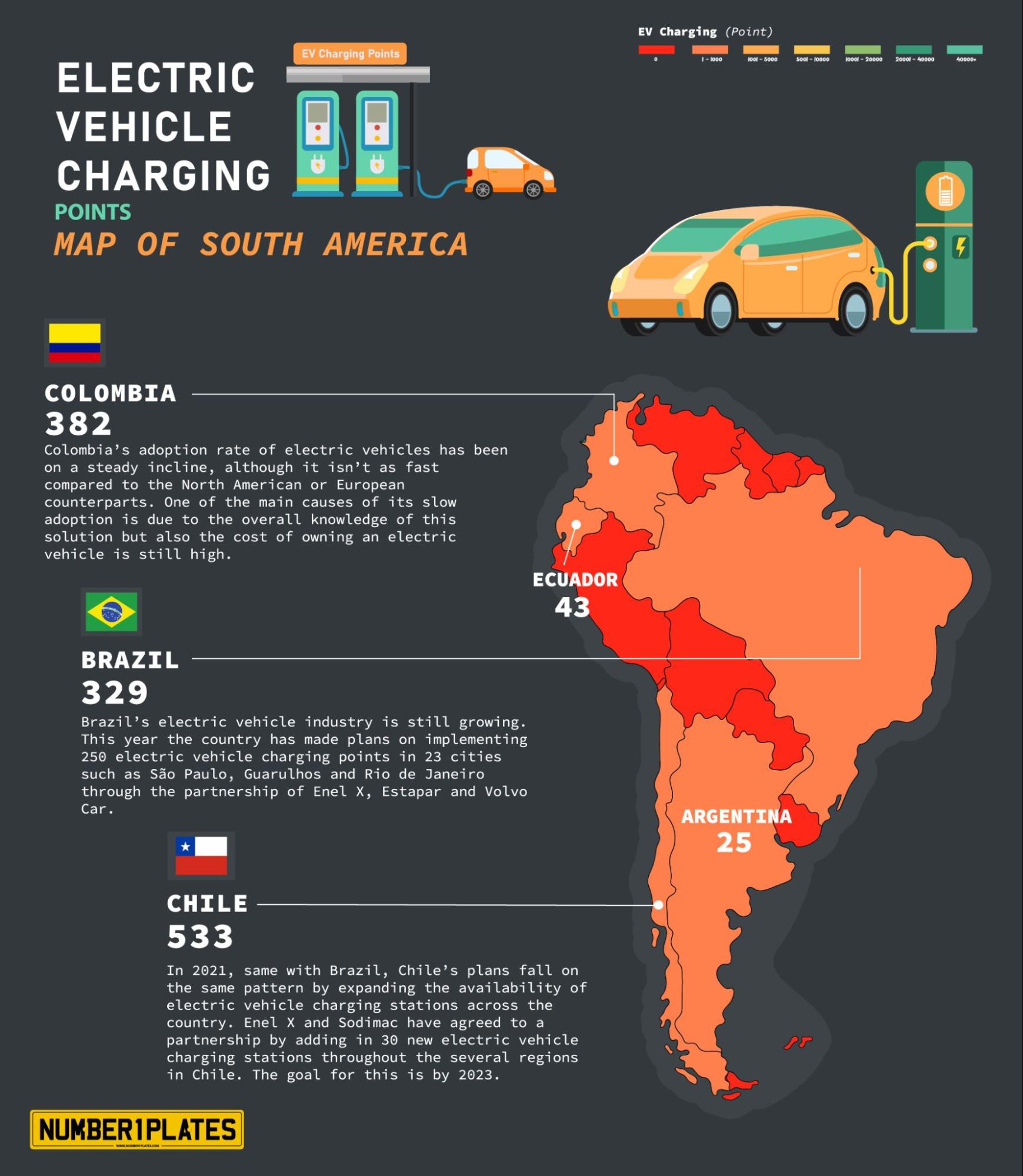
There has been an increase of government policies and initiatives that look to attract and encourage the use of electric vehicles in countries like Chile and Colombia. Much of this can be seen with the increase and demand of electric vehicle charging stations in the region. Rapid rise in the investment to develop EV charging infrastructure is also contributing to the growth of the South America EV Charging Stations market. However, there are still growing concerns of the rate of progress due to automakers in countries like Brazil and Argentina focusing on CO2 emitting cars which at the same time is providing a majority for their economic growth.
Key Findings
- Brazil – Brazil’s electric vehicle industry is still growing. This year the country has made plans on implementing 250 electric vehicle charging points in 23 cities such as São Paulo, Guarulhos and Rio de Janeiro through the partnership of Enel X, Estapar and Volvo Car.
- Chile – In 2021, same with Brazil, Chile’s plans fall on the same pattern by expanding the availability of electric vehicle charging stations across the country. Enel X and Sodimac have agreed to a partnership by adding in 30 new electric vehicle charging stations throughout the several regions in Chile. The goal for this is by 2023.
- Colombia – Colombia’s adoption rate of electric vehicles has been on a steady incline, although it isn’t as fast compared to the North American or European counterparts. One of the main causes of its slow adoption is due to the overall knowledge of this solution but also the cost of owning an electric vehicle is still high.
Asia
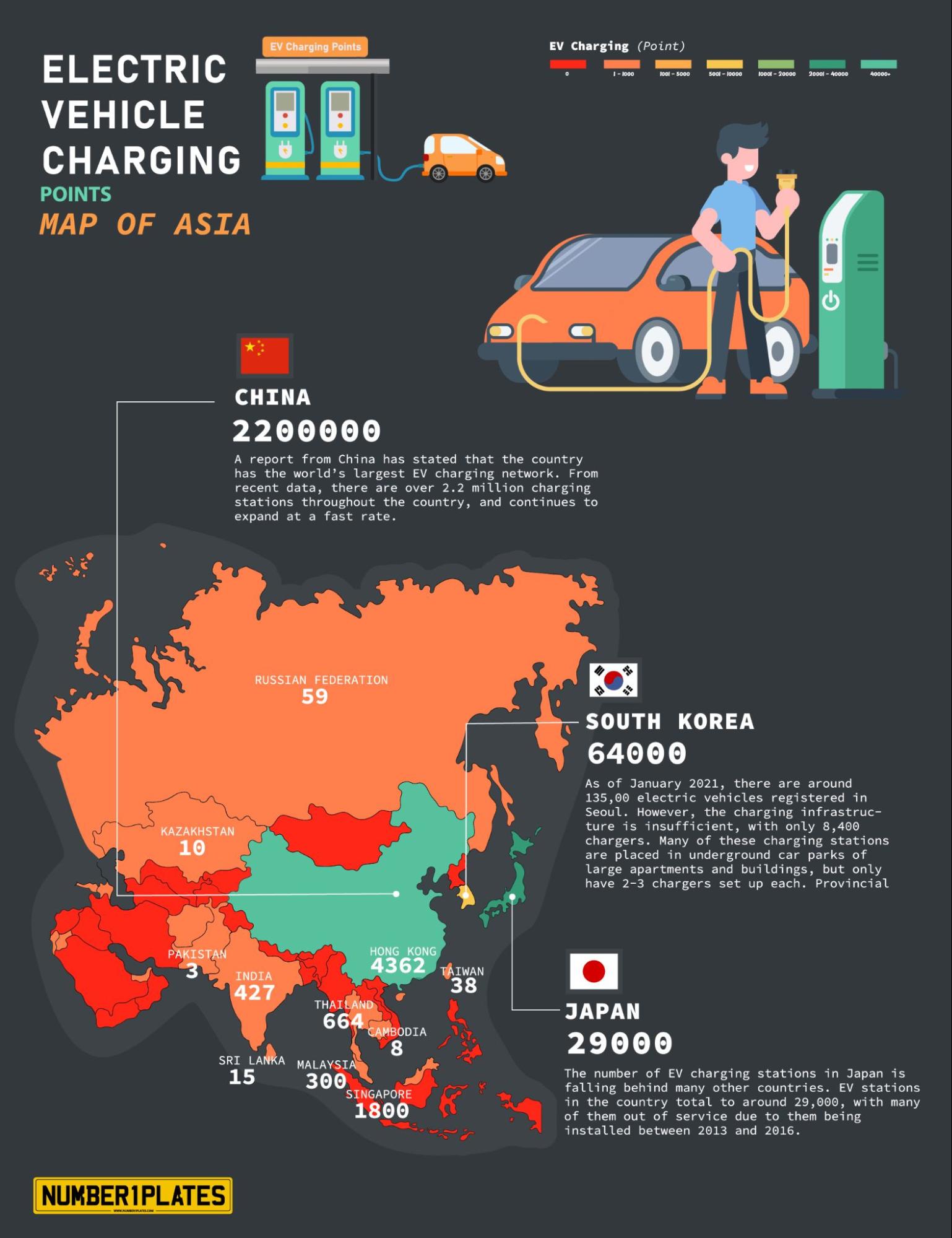
Due to the urgent need to address environmental concerns, investments from regional governments including China and South Korea has led to the continent’s growth in public charging infrastructure, in company with the expanding electric vehicle adoption in the region.
Automobile manufacturers are now investing in DC charging points, as the need for ultra-fast chargers are becoming necessary, especially with the entry of Tesla vehicles.
Key Findings
- China – A report from China has stated that the country has the world’s largest EV charging network. From recent data, there are over 2.2 million charging stations throughout the country, and continues to expand at a fast rate.
- Japan – The number of EV charging stations in Japan is falling behind many other countries. EV stations in the country total to around 29,000, with many of them out of service due to them being installed between 2013 and 2016.
- South Korea – As of January 2021, there are around 135,00 electric vehicles registered in Seoul. However, the charging infrastructure is insufficient, with only 8,400 chargers. Many of these charging stations are placed in underground car parks of large apartments and buildings, but only have 2-3 chargers set up each. Provincial governments, power companies, and private companies are improving the establishment of charging stations. Seoul City said in June that they plan to set up about 5,000 more EV chargers by the end of 2022.
Middle East
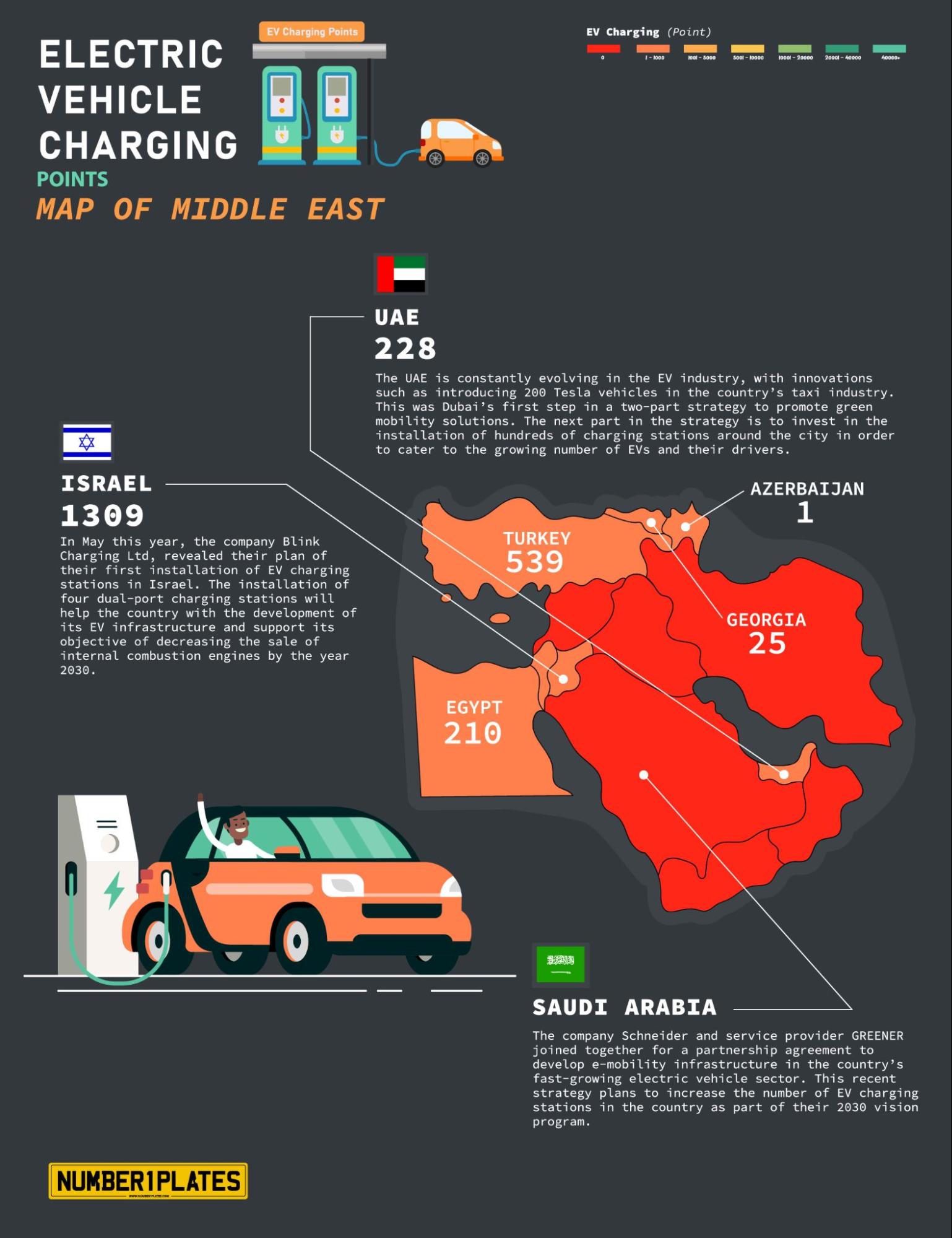
The Middle East electric vehicle charging infrastructure market is expected to increase due to the rising pollution levels in the developed countries across the region. Growing demand for effective pollution control strategies coupled with a surge in demand for electric vehicles in the region has become vital for the region to progress in an energy efficient climate.
Additionally, laws stated by the governments of these countries for the adoption of electric vehicles have been a significant solution for the current pollution issue. This is expected to launch the growth of the Middle East electric vehicle charging infrastructure market in the future.
Key Findings
- UAE – The UAE is constantly evolving in the EV industry, with innovations such as introducing 200 Tesla vehicles in the country’s taxi industry. This was Dubai’s first step in a two-part strategy to promote green mobility solutions. The next part in the strategy is to invest in the installation of hundreds of charging stations around the city in order to cater to the growing number of EVs and their drivers.
- Israel – In May this year, the company Blink Charging Ltd, revealed their plan of their first installation of EV charging stations in Israel. The installation of four dual-port charging stations will help the country with the development of its EV infrastructure and support its objective of decreasing the sale of internal combustion engines by the year 2030.
- Saudi Arabia – The company Schneider and service provider GREENER joined together for a partnership agreement to develop e-mobility infrastructure in the country’s fast-growing electric vehicle sector. This recent strategy plans to increase the number of EV charging stations in the country as part of their 2030 vision program.
Africa
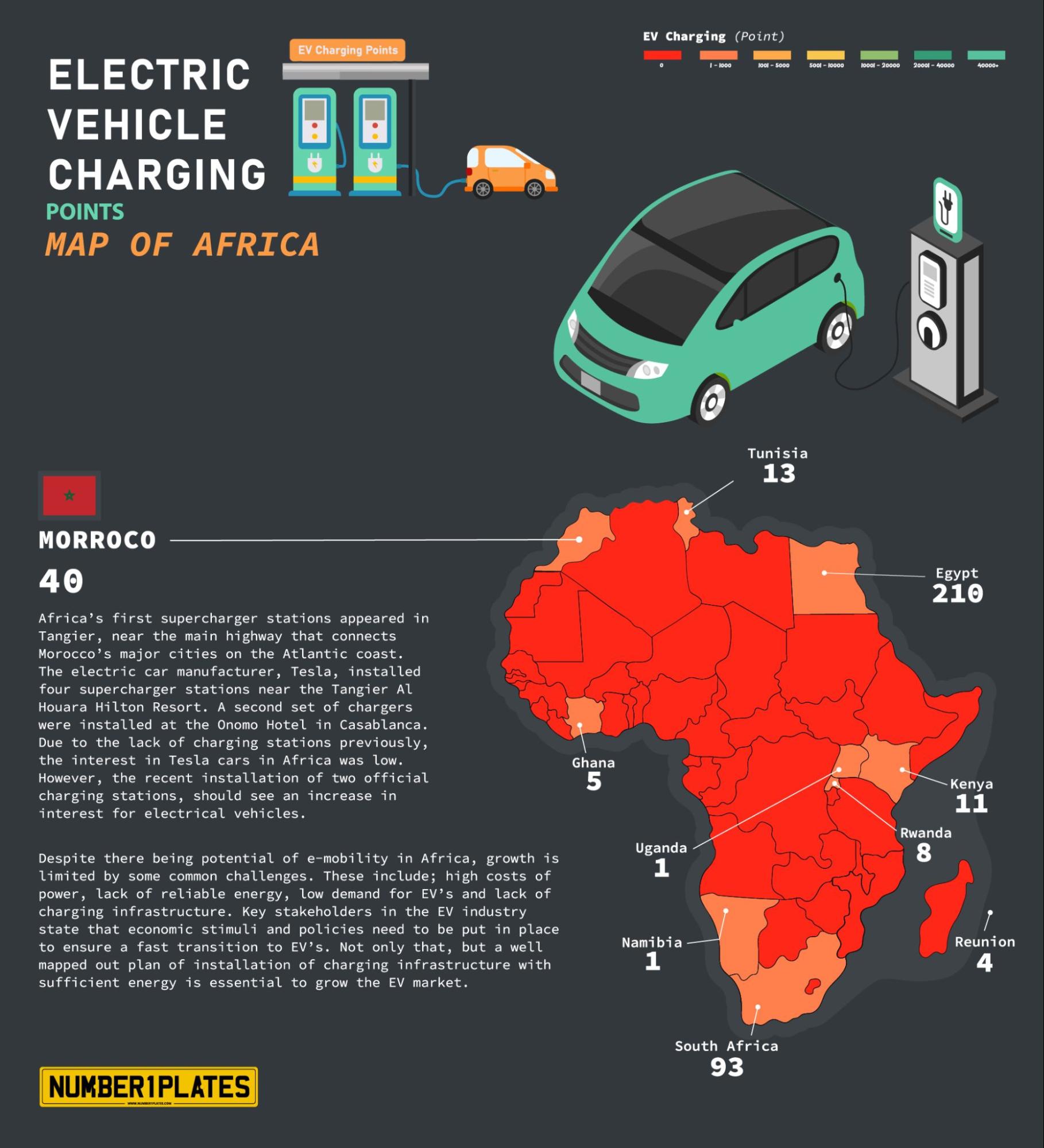
Despite the potential of e-mobility in Africa, growth is limited by some common challenges. These include; high costs of power, lack of reliable energy, low demand for EV’s and lack of charging infrastructure. Key stakeholders in the EV industry state that economic stimuli and policies need to be put in place to ensure a fast transition to EV’s. Not only that, but a well mapped out plan of installation of charging infrastructure with sufficient energy is essential to grow the EV market.
Key Findings
- Morocco – Africa’s first supercharger stations appeared in Tangier, near the main highway that connects Morocco’s major cities on the Atlantic coast. The electric car manufacturer, Tesla, installed four supercharger stations near the Tangier Al Houara Hilton Resort. A second set of chargers were installed at the Onomo Hotel in Casablanca. Due to the lack of charging stations previously, the interest in Tesla cars in Africa was low. However, the recent installation of two official charging stations, should see an increase in interest for electrical vehicles.
Oceania
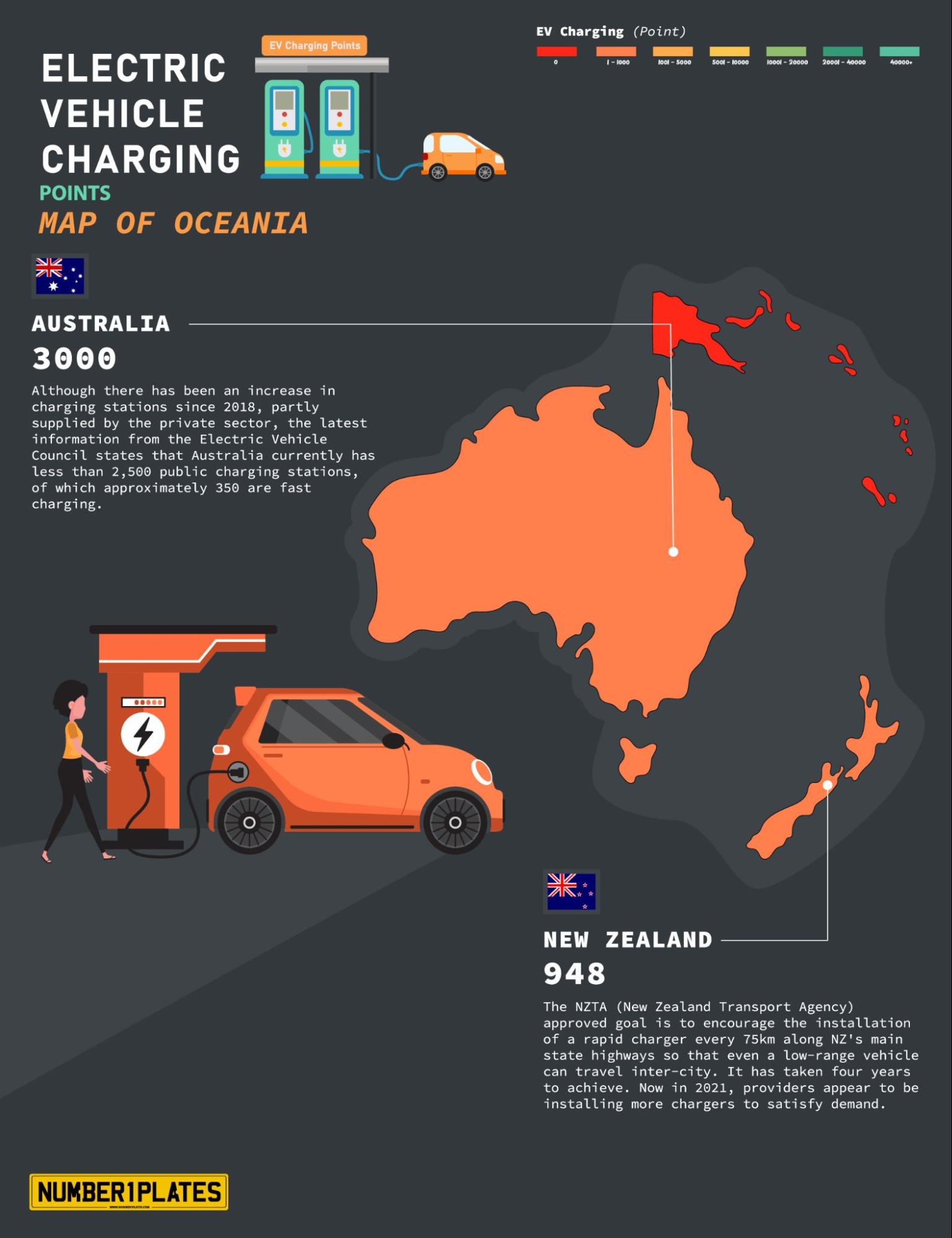
Drivers in Australia are taking the full advantage of electric vehicles as statistics show that EV drivers are reaching more distance compared to petrol vehicle drivers. Although, EV are driven more around cities and urban areas, the adoption of this form of travel is welcomed by many and is progressing to become the future for the country’s automobile scene. However, the narrative is the same as with all regions, the need for EV drivers is needed more in order to face the climate change issues.
Key Findings
- Australia – Although there has been an increase in charging stations since 2018, partly supplied by the private sector, the latest information from the Electric Vehicle Council states that Australia currently has less than 2,500 public charging stations, of which approximately 350 are fast charging.
- New Zealand – The NZTA (New Zealand Transport Agency) approved goal is to encourage the installation of a rapid charger every 75km along NZ’s main state highways so that even a low-range vehicle can travel inter-city. It has taken four years to achieve. Now in 2021, providers appear to be installing more chargers to satisfy demand.
Methodology
Data was collected from open map sources that provide the availability of EV charging points across the world. In areas that didn’t provide this, statistical data and news articles were used to fill in the gaps that were not provided by these open map sources.
For the table, the rating is based on the percentage of the entire country for China. This is a very large country compared to the rest of the other countries. Therefore, China was given a separate ration for the rest of the countries in the ranking. Use the 100% rate for all countries except China to calculate the percentage of the rest of the countries in the ranking. Based on the size of the design and the data of the EV charging station. You can rely on cross multiplication to find the correct percentage for countries from the top 2 to 10.



 100% Road Legal
100% Road Legal Express Delivery
Express Delivery


